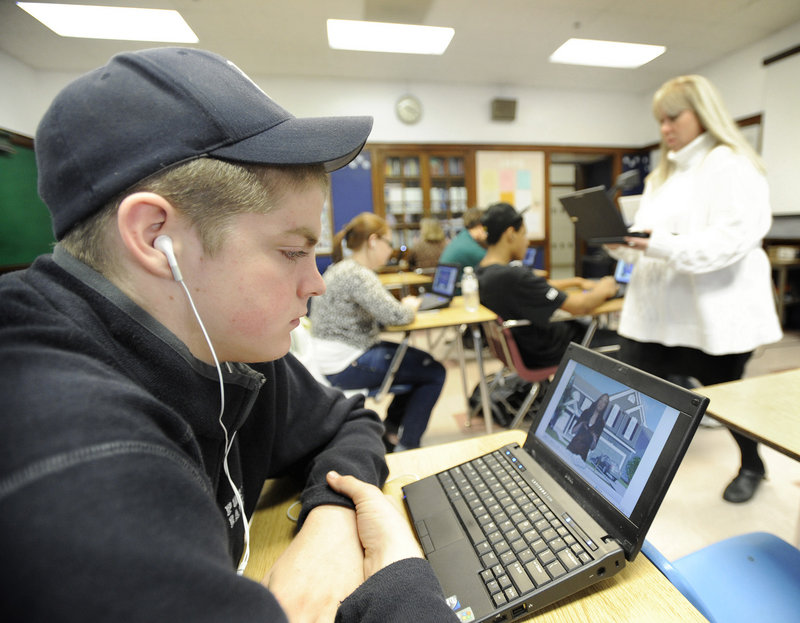PORTLAND — Unlike many of his peers at Portland High School, Matt McInnis knows something about personal finance.
He’s had a savings account since he was 4 years old and he works part time at Maine Red Claws basketball games. Now a senior, he’s saving money to study criminal justice at Husson University in Bangor.
Still, as McInnis enters adulthood, he concedes that the broader financial landscape looks increasingly complicated, despite the efficiency of online banking and other benefits of modern technology.
His concerns have been eased by EverFi, an interactive financial literacy program that’s now being used in several Maine high schools thanks to a $10,000 annual grant from Bangor Savings Bank.
With three-dimensional environments, animated avatars and Twitter-like messaging tools, EverFi helps students experience what it’s like to apply for a college loan, manage credit card debt, rent an apartment or buy a house, pay taxes and insurance and prepare for retirement.
“It’s all a little scary,” McInnis said. “But EverFi makes everything a little more clear to me. A lot of students are better with visual and hands-on things.”
EverFi is a three-year-old online program with Maine roots that’s being used in 48 states. It will be operating in more than 3,000 high schools and colleges by the end of this academic year, said Jon Chapman, chief operating officer.
Chapman and fellow Bowdoin College graduates Ray Martinez and Tom Davidson started the company after they moved to the Washington, D.C., area. Davidson is a former Maine legislator who was elected during his senior year at Bowdoin and was a strong supporter of the state’s innovative school laptop initiative, Chapman said.
Bangor Savings is sponsoring EverFi at Portland, Deering, South Portland, Catherine McAuley and Brewer high schools and Hampden Academy, Chapman said. the end of June, 40 Maine high schools will be using the program, including several sponsored by Machias Savings Bank and Camden National Bank. While students may become banking customers in the future, the program’s stated aim is to better prepare students to handle their money.
“The banks who work with us have two goals,” Chapman said. “They want to give back to their communities, and they want to help create more educated future consumers.”
Working together, EverFi and banks are fortifying high school curriculums that have shifted their focus from practical to academic skills and been trimmed by budget cuts. In the wake of those changes, many students graduate without a basic understanding of personal finance.
“It’s something that’s so essential for high school students to have before they venture out into the world, and it’s something that’s not often taught today,” said Carol Colson, Bangor Savings’ spokeswoman. “Without that knowledge, their start in life is much harder.”
Colson said she was impressed with EverFi’s emphasis on the importance of building good credit, even before students graduate from college. “They need to understand how unfortunate it is to ruin your credit rating before you even really need it,” she said.
At Portland High, a dozen students are using EverFi in an elective personal finance course taught by Nancy Harkins. Principal Mike Johnson said the program will be available to all students through the high school’s career center. He hopes to incorporate it into the regular social studies curriculum in the future.
Harkins said she uses EverFi to bring life to textbook lessons that can otherwise be quite dull. After she introduces and discusses lessons with students, they work individually on netbooks provided by the district, practicing what they’ve learned. Avatars like Rufus, a doltish character, accompany the students through various activities.
For most of Harkins’ students, EverFi offers a rare opportunity for first-time experiences. Few of them have bank accounts, and few of their parents have talked to them about money matters.
Yet, within a few years or even months, most of them will have credit cards. Half of all undergraduate college students surveyed in 2008 had four or more credit cards, and 76 percent of them had credit card debt averaging $2,200, according to Sallie Mae, which provides saving programs, planning resources and financing options for college students.
“They start getting credit card applications when they start applying for college,” Harkins said. “With EverFi, they can physically go into the bank and deposit money. It can take them places they’ve never been before.”
Staff Writer Kelley Bouchard can be contacted at 791-6328 or at: kbouchard@pressherald.com
Copy the Story Link
Send questions/comments to the editors.



Success. Please wait for the page to reload. If the page does not reload within 5 seconds, please refresh the page.
Enter your email and password to access comments.
Hi, to comment on stories you must . This profile is in addition to your subscription and website login.
Already have a commenting profile? .
Invalid username/password.
Please check your email to confirm and complete your registration.
Only subscribers are eligible to post comments. Please subscribe or login first for digital access. Here’s why.
Use the form below to reset your password. When you've submitted your account email, we will send an email with a reset code.